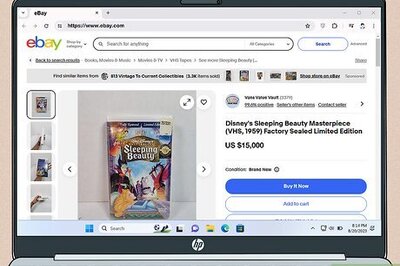
views
General Sand Dollar Meanings
Abundance and blessings Because sand dollars are found in abundance along coastlines, they’re sometimes symbols of prosperity and good fortune. They also resemble the Spanish dollar coins they’re named after, so they’re associated with financial and material blessings.
Connection to the sea and nature Sand dollars are a great reminder of the sea’s beauty and mystery. They remind us to appreciate and connect with nature, and are perfect for those who feel a deep connection with the ocean.
Sand Dollar Spiritual Meanings
Peace and tranquility Sand dollars are commonly associated with tranquility because the teeth-like apparatuses in their jaw resemble small, white birds like doves, a notable symbol of peace. Sand dollar charms are popular with those seeking a sense of calmness and serenity in their lives.
Wholeness and unity Sand dollars’ exoskeletons feature a pattern that resembles a flower or star. This pattern is often seen as a symbol of completeness; each “petal” is connected, representing harmony and balance.
Personal growth and resilience Because sand dollars can anchor themselves against strong currents, they’re often a symbol of inner strength and adaptability. Sand dollars represent the ability to withstand and adapt to life’s challenges.
Sand Dollar Cultural Meanings & Legends
In Christianity, sand dollars represent the resurrection of Jesus Christ. One of the most well-known sand dollar legends is the “Legend of the Sand Dollar,” written by screenwriter Chris Auer. This story compares the five slits on a sand dollar to the five wounds on Christ, and the star in the middle to the star of Bethlehem. Additionally, the back of a sand dollar resembles a poinsettia, a flower associated with Christmas and the star of Bethlehem. When a sand dollar is broken open, the five “teeth” (or jaw apparatuses) resemble doves, which symbolize the Holy Spirit, peace, and goodwill.
Sand dollars are associated with the legend of Atlantis. According to some legends, sand dollars were the coins used by the people of the lost city of Atlantis. Other folktales claim that they are the currency used by mermaids.
Are sand dollars good luck?
Many believe sand dollars are good luck. Because sand dollars are generally considered positive symbols, people often believe it’s good luck to find one on the beach. If you find a living sand dollar, just be sure to return it to the water, as it’s illegal in most places to take them. In most cases, it’s okay to take ones that are already dead and dried out.
How to Collect Sand Dollars
Only collect dead sand dollars. Sand dollars are an important part of our ecosystem, so you should never remove a living sand dollar from its habitat. Living sand dollars are usually fuzzy and brown, gray, or purple. Dead sand dollars are white, as they’ve been bleached by the sun. If you find a living sand dollar on the beach, gently return it to the water, as they can only survive a few minutes on land. If you aren’t sure if a sand dollar is living or dead, it’s best to leave it be. Remember to follow your beach’s regulations, as well. Some may allow you to collect shells and sea creatures, while others do not permit it regardless of whether they’re dead or not.
Look for sand dollars during low tide. In general, you’re most likely to find sand dollars during low tide, after they’ve been washed ashore. Walk near the high tide line and look for round patches or depressions in the sand.
Preserve collected sand dollars by soaking them in freshwater. To clean and preserve your sand dollars, soak them in a clean bowl or bucket of freshwater. Swap out the water whenever it starts looking dirty or murky, and repeat the process until the water remains clean. Then, allow the sand dollars to air dry on a towel. If you want to whiten your sand dollar, soak it in a 3:1 mixture of freshwater and bleach for a few minutes. Don’t leave it in the mixture long, as bleach will dissolve it. To harden your sand dollar, brush on a 1:1 mixture of water and Elmer’s white glue.
What to Do If You Find a Sand Dollar
Return live sand dollars to the sea. While it’s usually okay to collect dead sand dollars, in most places, it is illegal to take living ones. If you find a live sand dollar on the beach, gently return it to the ocean. They can only survive for a few minutes outside of water.
What are sand dollars?
Sand dollars are burrowing sea urchins. Sand dollars are a type of spiny, bottom-dwelling sea urchin that use their spines to eat. They don’t have brains and instead use a “nerve ring” to regulate their body functions. They’re protected by an exoskeleton, and internally, have a jaw that contains five teeth-like sections, 50 calcified skeletal elements, and 60 muscles. Sand dollars are an important part of the ocean’s ecosystem, as they help control the population of smaller invertebrates and are a source of food for some larger organisms. Sand dollars also have a star-shaped pattern on their bodies, which is one of the reasons people like to collect them. When sand dollars reproduce, fertilization occurs externally, leading to the development of free-swimming larvae. The larvae eventually settle on the ocean floor, undergo metamorphosis, and transform into young sand dollars.
Why are they called sand dollars?
Sand dollars are named after the Spanish dollar. Sometimes, people get confused about the name of the sand dollar, as the sea creature does not resemble the modern American dollar. However, sand dollars are actually named after old Spanish and American dollar coins. The size and shape of a sand dollar’s exoskeleton is similar to the size and shape of a large coin. Sand dollars are also sometimes known as sand cakes, pansy shells, snapper biscuits, cake urchins, and sea cookies. Despite their name, living sand dollars are usually worth $5-15 dollars at an aquarium. Many souvenir shops sell dead sand dollars for $1-5.
Where do sand dollars come from?
Sand dollars are found in the Pacific, Caribbean, and Atlantic oceans. Sand dollars live in temperate and tropical waters around the world and can be found everywhere from Alaska to Indonesia. They’re bottom-dwellers, so they typically live in sandy or muddy areas below the surface. They often wash ashore during high tide.
Sand Dollar Fun Facts
Sand dollars are one of the most fascinating sea creatures. Sand dollars have a unique way of eating, moving, and reproducing, which is why so many people are interested in learning about them and collecting them. Here are a few more fun facts about sand dollars: Sand dollars’ age can be determined by counting the growth rings on their exoskeleton. Sand dollars typically live for 6-10 years. Young sand dollars sometimes eat sand to add weight and anchor themselves against powerful currents. It can take up to two days for sand dollars to digest the food they consume. Sand dollars move by pumping water through their pores to propel themselves forward. When sand dollars burrow, they provide more oxygen at lower levels of the ocean floor, allowing for greater biodiversity.

















Comments
0 comment